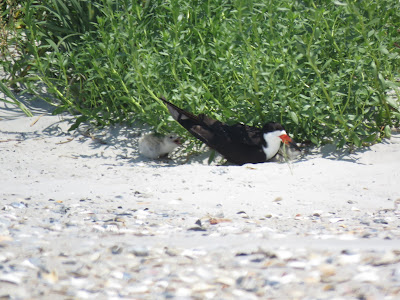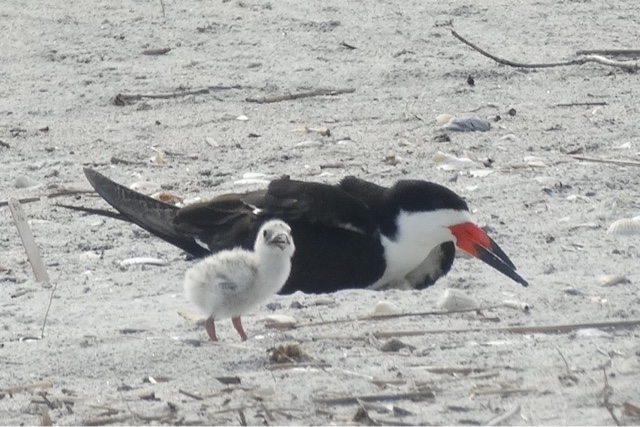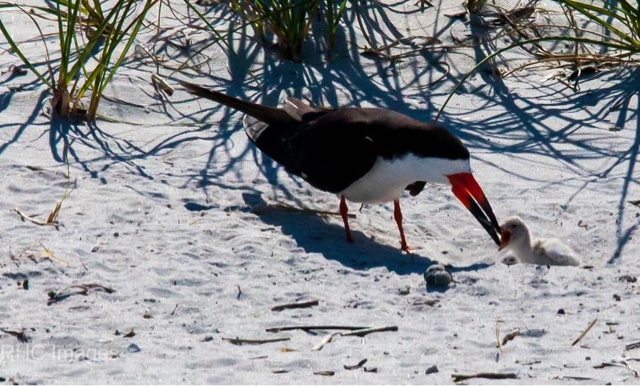This summer, the colony has 349 least tern pairs, 123 black skimmer pairs, 14 common tern pairs and four oystercatcher pairs. Those numbers are fairly typical, Addison said. The highest number of pairs observed was 597 in 2012, while only a few were counted in 2014 when beach renourishment dredging affected their habitat.
The four nesting bird species form a colony with what Addison called “a little bit of competition and a little bit of benefit.”
The least tern chicks hatched about one month ago, and now they are learning how to fly. They are the same size as the adults, Addison said, but don’t yet have the distinct black markings.
Most of the least tern chicks are about the same age, but a few might be younger if the parents’ eggs failed to hatch and they had to lay more. Nesting together makes it easier for the adults to defend the chicks and eggs, Addison said.
“It helps them to drive away predators,” she said, “because all the terns can get up and chase away a crow that might want to eat their eggs or chicks.”
The terns might defend their nests as a pack, but they only brood and feed their own young, Addison said. Both parents catch small fish from the ocean to feed their chicks.
Several weeks after the terns nested, the black skimmers nested, and their chicks hatched about one week ago, Addison said June 16. They nest after the terns so they can take advantage of the terns’ protection against predators.
“The terns are really aggressive defending the colony,” she said. “The skimmers aren’t as good at that.”
In Wrightsville Beach’s colony, the skimmers tend to congregate closer to the dunes than the terns do. Competition occasionally arises between the species if a skimmer nests too close to a tern.
“A skimmer can displace a tern because the skimmers are bigger,” Addison said.
Common tern chicks have also recently hatched, she added. Adult common terns are slightly larger than least terns with a solid black cap of feathers and a bright red bill.
The oystercatcher is the only species in the sanctuary that has not yet raised any chicks. The four pairs’ eggs hatched, Addison said, but the chicks did not survive.
“I don’t know why,” she said. “Usually we do have at least a few fledglings succeed.”
She’s worried human behavior might affect the oystercatchers. Unlike the other species that are colonial, meaning they nest in a group, oystercatchers are solitary nesters.
Because their nests aren’t located with the rest of the colony at the southern tip of the sanctuary, they are less obvious to beachgoers, Addison said. Postings and signs mark the entire sanctuary, but Addison said people occasionally enter the sanctuary if they don’t see any birds around.
“They’ll ignore the signs and walk under the string,” she said. “They’re disturbing oystercatchers, and that can cause them to lose the chicks.”
Beachgoers can also disturb the birds from outside the postings, Addison added. She has seen people try to feed the birds by tossing small dead fish into the sanctuary. But nesting birds only eat live fish they catch from the ocean, Addison said, so the actions of the well-meaning beachgoers only served to attract predators like gulls to the area.
Onlookers should also be aware if their presence is causing the birds to become agitated enough to fly away, she added. Even if people are outside the sanctuary, if they notice the birds taking to the air in numbers they should back away.
“If the birds fly off their eggs or chicks, a gull or a crow can come in and grab them,” she said.
Volunteers have placed tiny structures in the sanctuary in which the chicks can seek shelter from crows and gulls. Chicks will also shelter in the sparse vegetation, which protects them from both predators and heat.
If a chick or an egg is exposed to the direct summer sunlight for as short a time as 15 minutes, Addison said, it could overheat and die.
“It’s harsh out there on the beach,” she said. “Anyone who has tried to walk barefoot on the sand can tell you that.”
Addison encouraged people who have further questions about Wrightsville’s nesting birds to participate in weekly tours of the sanctuary led by Audubon North Carolina’s Wrightsville Beach bird stewards every Monday at 9 a.m.
email emmy@luminanews.com


















































